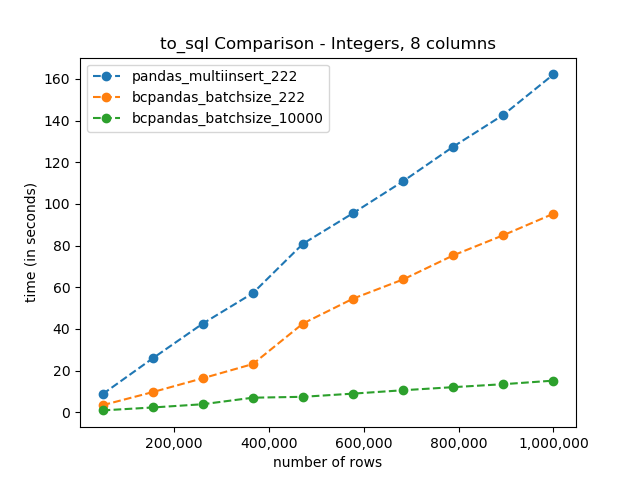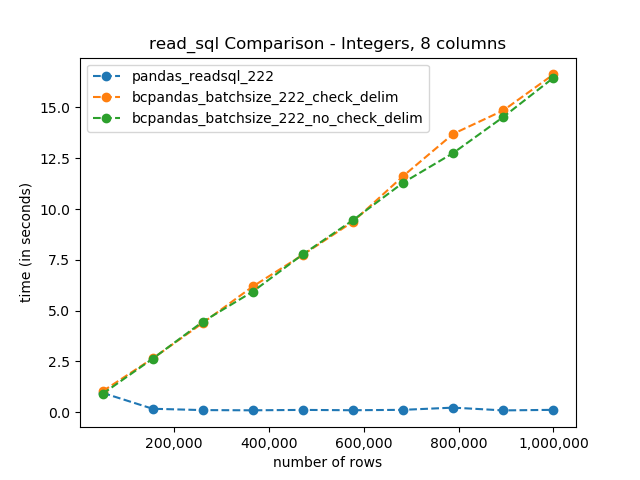bcpandas
High-level wrapper around BCP for high performance data transfers between pandas and SQL Server. No knowledge of BCP required!! (pronounced BEE-CEE-Pandas)
- Quickstart
- IMPORTANT - Read vs. Write
- Benchmarks
- Requirements
- Installation
- Usage
- Known Issues
- Background
- Testing
- CI/CD
- Contributing
- GitHub Stars Trend
Quickstart
In [1]: import pandas as pd
...: import numpy as np
...:
...: from bcpandas import SqlCreds, to_sql
In [2]: creds = SqlCreds(
...: 'my_server',
...: 'my_db',
...: 'my_username',
...: 'my_password'
...: )
In [3]: df = pd.DataFrame(
...: data=np.ndarray(shape=(10, 6), dtype=int),
...: columns=[f"col_{x}" for x in range(6)]
...: )
In [4]: df
Out[4]:
col_0 col_1 col_2 col_3 col_4 col_5
0 4128860 6029375 3801155 5570652 6619251 7536754
1 4849756 7536751 4456552 7143529 7471201 7012467
2 6029433 6881357 6881390 7274595 6553710 3342433
3 6619228 7733358 6029427 6488162 6357104 6553710
4 7536737 7077980 6422633 7536732 7602281 2949221
5 6357104 7012451 6750305 7536741 7340124 7274610
6 7340141 6226036 7274612 7077999 6881387 6029428
7 6619243 6226041 6881378 6553710 7209065 6029415
8 6881378 6553710 7209065 7536743 7274588 6619248
9 6226030 7209065 6619231 6881380 7274612 3014770
In [5]: to_sql(df, 'my_test_table', creds, index=False, if_exists='replace')
In [6]: df2 = pd.read_sql_table(table_name='my_test_table', con=creds.engine)
In [7]: df2
Out[7]:
col_0 col_1 col_2 col_3 col_4 col_5
0 4128860 6029375 3801155 5570652 6619251 7536754
1 4849756 7536751 4456552 7143529 7471201 7012467
2 6029433 6881357 6881390 7274595 6553710 3342433
3 6619228 7733358 6029427 6488162 6357104 6553710
4 7536737 7077980 6422633 7536732 7602281 2949221
5 6357104 7012451 6750305 7536741 7340124 7274610
6 7340141 6226036 7274612 7077999 6881387 6029428
7 6619243 6226041 6881378 6553710 7209065 6029415
8 6881378 6553710 7209065 7536743 7274588 6619248
9 6226030 7209065 6619231 6881380 7274612 3014770IMPORTANT - Read vs. Write
The big speedup benefit of bcpandas is in the to_sql function, as the benchmarks below show. However, the bcpandas read_sql function actually performs slower than the pandas equivalent. Therefore, the bcpandas read_sql function was deprecated in v5.0 and has now been removed in v6.0+. To read data from SQL to pandas, use the native pandas method pd.read_sql_table or pd.read_sql_query.
Benchmarks
See figures below. All code is in the /benchmarks directory. To run the benchmarks, from the root directory of this repository, run python benchmarks/benchmark.py main --help and fill in the command line options that are presented.
Running this will output
- PNG image of the graph
- JSON file of the benchmark data
- JSON file with the environment details of the machine that was used to generate it
to_sql
I didn't bother including the pandas non-
multiinsertversion here because it just takes way too long
Why not just use the new pandas method='multi'?
- Because it is still much slower
- Because you are forced to set the
chunksizeparameter to a very small number for it to work - generally a bit less then2100/<number of columns>. This is because SQL Server can only accept up to 2100 parameters in a query. See here and here for more discussion on this, and the recommendation to use a bulk insert tool such as BCP. It seems that SQL Server simply didn't design the regularINSERTstatement to support huge amounts of data.
read_sql
As you can see, pandas native clearly wins here
Requirements
Database
Any version of Microsoft SQL Server. Can be installed on-prem, in the cloud, on a VM, or one of the Azure versions.
Python User
- BCP Utility
- Microsoft ODBC Driver 11, 13, 13.1, or 17 for SQL Server. (Microsoft Docs) See the pyodbc docs for more on different driver versions.
- Python >= 3.7
pandas>= 0.19sqlalchemy>= 1.0pyodbcas the supported DBAPI
Installation
| Source | Command |
|---|---|
| PyPI | pip install bcpandas |
| Conda | conda install -c conda-forge bcpandas |
Usage
- Create creds (see next section)
- Replace any
df.to_sql(...)in your code withbcpandas.to_sql(df, ...)
That's it!
Credential/Connection object
Bcpandas requires a bcpandas.SqlCreds object in order to use it, and also a sqlalchemy.Engine. The user has 2 options when constructing it.
-
Create the bcpandas
SqlCredsobject with just the minimum attributes needed (server, database, username, password), and bcpandas will create a fullEngineobject from this. It will usepyodbc,sqlalchemy, and the Microsoft ODBC Driver for SQL Server, and will store it in the.engineattribute.In [1]: from bcpandas import SqlCreds In [2]: creds = SqlCreds('my_server', 'my_db', 'my_username', 'my_password') In [3]: creds.engine Out[3]: Engine(mssql+pyodbc:///?odbc_connect=Driver={ODBC Driver 17 for SQL Server};Server=tcp:my_server,1433;Database=my_db;UID=my_username;PWD=my_password)
-
Pass a full
Engineobject to the bcpandasSqlCredsobject, and bcpandas will attempt to parse out the server, database, username, and password to pass to the command line utilities. If a DSN is used, this will fail.(continuing example above)
In [4]: creds2 = SqlCreds.from_engine(creds.engine) In [5]: creds2.engine Out[5]: Engine(mssql+pyodbc:///?odbc_connect=Driver={ODBC Driver 17 for SQL Server};Server=tcp:my_server,1433;Database=my_db;UID=my_username;PWD=my_password) In [6]: creds2 Out[6]: SqlCreds(server='my_server', database='my_db', username='my_username', with_krb_auth=False, engine=Engine(mssql+pyodbc:///?odbc_connect=Driver={ODBC Driver 17 for SQL Server};Server=tcp:my_server,1433;Database=my_db;UID=my_username;PWD=my_password), password=[REDACTED])
Recommended Usage
| Feature | Pandas native | BCPandas |
|---|---|---|
| Super speed | ❌ | ✅ |
| Good for simple data types like numbers and dates | ❌ | ✅ |
| Handle messy string data | ✅ | ❌ |
built with the help of https://www.tablesgenerator.com/markdown_tables# and https://gist.github.com/rxaviers/7360908
Known Issues
Here are some caveats and limitations of bcpandas.
- Bcpandas has been tested with all ASCII characters 32-127. Unicode characters beyond that range have not been tested.
- An empty string (
"") in the dataframe becomesNULLin the SQL database instead of remaining an empty string. - Because bcpandas first outputs to CSV, it needs to use several specific characters to create the CSV, including a delimiter and a quote character. Bcpandas attempts to use characters that are not present in the dataframe for this, going through the possilbe delimiters and quote characters specified in
constants.py. If all possible characters are present in the dataframe and bcpandas cannot find both a delimiter and quote character to use, it will throw an error.- The BCP utility does not ignore delimiter characters when surrounded by quotes, unlike CSVs - see here in the Microsoft docs.
If there is a NaN/Null in the last column of the dataframe it will throw an error. This is due to a BCP issue. See my issue with Microsoft about this here.This doesn't seem to be a problem based on the tests.
Background
Writing data from pandas DataFrames to a SQL database is very slow using the built-in to_sql method, even with the newly introduced execute_many option. For Microsoft SQL Server, a far far faster method is to use the BCP utility provided by Microsoft. This utility is a command line tool that transfers data to/from the database and flat text files.
This package is a wrapper for seamlessly using the bcp utility from Python using a pandas DataFrame. Despite the IO hits, the fastest option by far is saving the data to a CSV file in the file system and using the bcp utility to transfer the CSV file to SQL Server. Best of all, you don't need to know anything about using BCP at all!
Existing Solutions
Much credit is due to
bcpyfor the original idea and for some of the code that was adopted and changed.
bcpy
bcpy has several flaws:
- No support for reading from SQL, only writing to SQL
- A convoluted, overly class-based internal design
- Scope a bit too broad - deals with pandas as well as flat files
This repository aims to fix and improve on
bcpyand the above issues by making the design choices described earlier.
Design and Scope
The only scope of bcpandas is to read and write between a pandas DataFrame and a Microsoft SQL Server database. That's it. We do not concern ourselves with reading existing flat files to/from SQL - that introduces way to much complexity in trying to parse and decode the various parts of the file, like delimiters, quote characters, and line endings. Instead, to read/write an exiting flat file, just import it via pandas into a DataFrame, and then use bcpandas.
The big benefit of this is that we get to precicely control all the finicky parts of the text file when we write/read it to a local file and then in the BCP utility. This lets us set library-wide defaults (maybe configurable in the future) and work with those.
For now, we are using the non-XML BCP format file type. In the future, XML format files may be added.
Testing
Testing Requirements
- Docker Desktop installed, either of the Linux or Windows runtimes, doesn't matter
- pytest
- hypothesis
- pytest-cov (coverage.py)
- docker-py (for controlling Docker)
What Is Tested?
We take testing very seriously here. In order to rely on a library like this in production, it MUST be ruthlessly tested, which thankfully it is. Here is a partial list of what has been tested so far. Pull Requests welcome!
- Data types: All ASCII characters 32-127 (using the Hypothesis library, see below). Unicode characters beyond that range have not been tested.
numpy.NaN,Nonenumpy.inf(fails, as expected)- Empty dataframe (nothing happens, database not modified)
- Duplicate column names (raises error)
- Database columns that are missing from the dataframe, are out of order, or both (passes)
- Extra dataframe columns that aren't in database, when
if_exists="append"specified (fails)
Testing Implementation
- Testing uses
pytest. - To test for all possible data types, we use the
hypothesislibrary, instead of trying to come up with every single case on our own. pytest-cov(which usescoverage.pyunder the hood) is used to measure code coverage. This is then uploaded to codecov.io as part of the CI/CD process (see below).- In order to spin up a local SQL Server during testing, we use Docker. Specifically, we run one of the images that Microsoft provides that already have SQL Server fully installed, all we have to do is use the image to run a container. Here are the links to the Linux versions and the Windows versions - Express and Developer.
- When running the tests, we can specify a specific Docker image to use, by invoking the custom command line option called
--mssql-docker-image. For example:pytest bcpandas/tests --mssql-docker-image mcr.microsoft.com/mssql/server:2019-latest
- When running the tests, we can specify a specific Docker image to use, by invoking the custom command line option called
- Instead of using the
subprocesslibrary to control Docker manually, we use the elegantdocker-pylibrary which works very nicely. ADockerDBPython class is defined inbcpandas/tests/utils.pyand it wraps up all the Docker commands and functionality needed to use SQL Server into one class. This class is used inconftest.pyin the core bcpandas tests, and in thebenchmarks/directory for both the benchmarks code as well as the legacy tests forread_sql.
CI/CD
Github Actions is used for CI/CD, although it is still somewhat a work in progress.
Contributing
Please, all contributions are very welcome!
I will attempt to use the pandas docstring style as detailed here.








